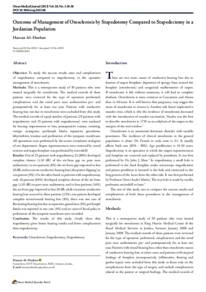Document
Outcome of management of otosclerosis by stapedotomy compared to stapedectomy in a Jordanian population.
Identifier
DOI 10.5001/omj.2013.08
Publisher
Oman Medical Specialty Board.
Gregorian
2013-01
Language
English
Subject
English abstract
Objective: To study the success results rates and complications of stapedotomy compared to stapedectomy in the operative management of otosclerosis.
Methods: This is a retrospective study of 50 patients who were treated surgically for otosclerosis. The medical records of these patients were reviewed for the type of operation performed, complications and the serial pure tune audiometries pre- and postoperatively for at least one year. Patients with conductive hearing loss not due to otosclerosis were excluded from this study. The medical records of equal number of patients (25 patients with stapedotomy and 25 patients with stapedectomy) were analyzed for hearing improvement or loss, postoperative nausea, vomiting, vertigo, nystagmus, perilymph fistula, reparative granuloma, labyrinthitis, tinnitus and perforation of the tympanic membrane. All operations were performed by the senior consultant-otologists of our department. Stapes superstructures were removed by crural scissors and stapes footplate was perforated by microdrill.
Results: Out of 25 patients with stapedotomy, 22 (88%) developed complete closure (≤10 dB) of the air-bone gap on pure tune audiometry; in two patients (8%), the air-bone gap improved to less 20 dB, and recurrent conductive hearing loss (due piston slipping) in one patient (4%). On the other hand, in patients with stapedectomy, only 16 patients (64%) developed complete closure of the air-bone gap (≤10 dB) on pure tune audiometry, and in four patients (16%) the air-bone gap improved to less 20 dB, while recurrent conductive hearing loss occured in three patients (12%), one patient developed complete sensorineural hearing loss (4%), there was one case of fluctuating hearing loss due to reparative granuloma (4%), perilymph fistula was reported in one case (4%) and no cases of facial palsy or perforation of the tympanic membrane were recorded.
Conclusion: The results of this study clearly show that stapedotomy gives better hearing results and fewer complications than stapedectomy.
Member of
Resource URL
Citation
Al-Husban, Hassan (2013). Outcome of management of otosclerosis by stapedotomy compared to stapedectomy in a Jordanian population. Oman Medical Journal, 28 (1), 36-38.
Category
Journal articles

